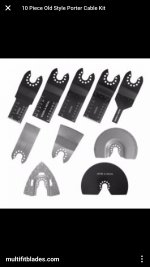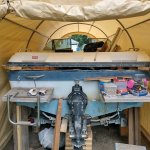ChronoFish
Cadet
- Joined
- Oct 26, 2015
- Messages
- 27
Hi - I started this project last year and focused on getting the motor running and then winterized it.. began removing rotten floor because it was soft in the back corners... but the damage turned out to be throughout the boat.
So tore up the floor, removed the foam all the way up to the bow seats. Had to stop there because the bow seats are attached to the gunnel as one big insert - so in order to remove the floor, you have to remove the entire cap. Shored up the boat, blocked the keel and edges of the boat (while leaving it on the trailer) and removed the rub rail and all the screws underneath.
Started lifting the gunnel and discovered, to my horror, that gunnel is fiberglassed to the transom. (yes old boat, who knows how many fixes it's been through)
So just for my own understanding, this isn't normal right? I mean Ebbtide wouldn't have done that - would they? I'm guessing my only recourse at this point is to cut the fiberglass along what should be the seam.
Attached pictures:
1. Outside boat shown the how the gunnel is separated from the bow, but not the stern.
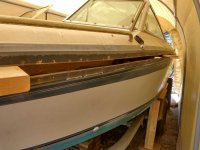
2. Inside looking at port side (transom corner) to see gap between gunnel and hull
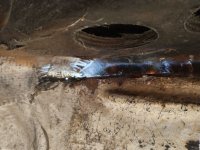
3. Inside looking at top of transom - notice no gap - just smooth fiberglass
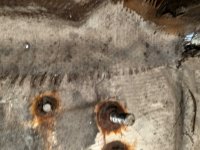
So tore up the floor, removed the foam all the way up to the bow seats. Had to stop there because the bow seats are attached to the gunnel as one big insert - so in order to remove the floor, you have to remove the entire cap. Shored up the boat, blocked the keel and edges of the boat (while leaving it on the trailer) and removed the rub rail and all the screws underneath.
Started lifting the gunnel and discovered, to my horror, that gunnel is fiberglassed to the transom. (yes old boat, who knows how many fixes it's been through)
So just for my own understanding, this isn't normal right? I mean Ebbtide wouldn't have done that - would they? I'm guessing my only recourse at this point is to cut the fiberglass along what should be the seam.
Attached pictures:
1. Outside boat shown the how the gunnel is separated from the bow, but not the stern.

2. Inside looking at port side (transom corner) to see gap between gunnel and hull

3. Inside looking at top of transom - notice no gap - just smooth fiberglass





















